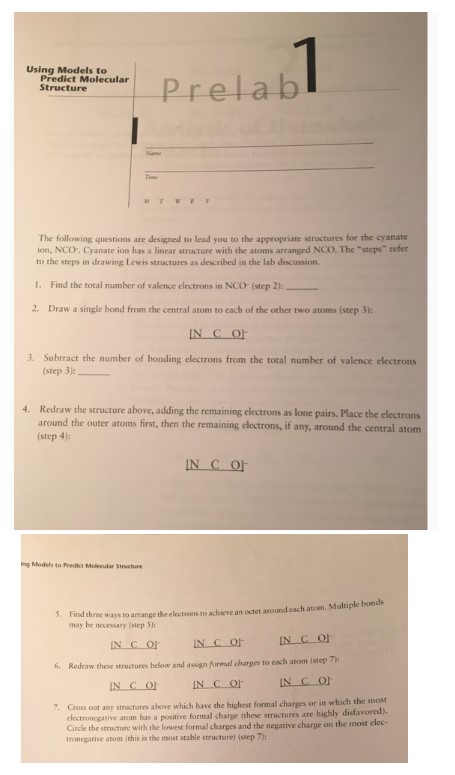QQuestionAnatomy and Physiology
QuestionAnatomy and Physiology
Using Models to Predict Molecular Structure
The following questions are designed to lead you to the appropriate structures for the cyanate ion, NCO. Cyanate ion has a linear structure with the atoms arranged NCO. The "steps" refer to the steps in drawing Lewis structures as described in the lab discussion.
1. Find the total number of valence electrons in NCO (step 2): _______
2. Draw a single bond from the central atom to each of the other two atoms (step 3):
[N C O]־
3. Subtract the number of bonding electrons from the total number of valence electrons (step 3): _______
4. Redraw the structure above, adding the remaining electrons as lone pairs. Place the electrons around the outer atoms first, then the remaining electrons, if any, around the central atom (step 4):
[N C O]־
ing Models to Predict Molecular Structure
5. Find three ways to arrange the electrons to achieve an octet around each atom. Multiple bonds may be necessary (step 5):
[N C O]־ [N C O]־ [N C O]־
6. Redraw these structures below and assign formal charges to each atom (step 7):
[N C O]־ [N C O]־ [N C O]־
7. Cross out any structures above which have the highest formal charges or in which the most electronegative atom has a positive formal charge (these structures are highly dialavored). Circle the structure with the lowest formal charges and the negative charge on the most electronegative atom (this is the most stable structure) (step 7):
Attachments

6 months agoReport content
Answer
Full Solution Locked
Sign in to view the complete step-by-step solution and unlock all study resources.
Step 1: Find the total number of valence electrons in NCO.
Nitrogen (N) is in group 15, which means it has 5 valence electrons. Carbon (C) is in group 14, which means it has 4 valence electrons. Oxygen (O) is in group 16, which means it has 6 valence electrons. So, the total number of valence electrons in NCO is: \text{Total valence electrons} = 5 (\text{N}) + 4 (\text{C}) + 6 (\text{O}) = 15 \text{ valence electrons}
Step 2: Draw a single bond from the central atom (N) to each of the other two atoms (C and O).
Subtract the number of bonding electrons (6) from the total number of valence electrons (15). \text{Valence electrons remaining} = \text{Total valence electrons} - \text{Bonding electrons} = 15 - 6 = 9 \text{ valence electrons}
Final Answer
The most stable structure for the cyanate ion, NCO, is linear with a triple bond between N and C, and a single bond between C and O, with a formal charge of - 1 on the oxygen atom: [N=C=O]^(-).
Need Help with Homework?
Stuck on a difficult problem? We've got you covered:
- Post your question or upload an image
- Get instant step-by-step solutions
- Learn from our AI and community of students